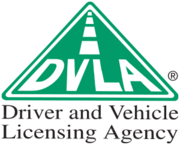Driver and Vehicle Licensing Agency facts for kids
 |
|
 The DVLA in Swansea |
|
| Agency overview | |
|---|---|
| Formed | 1965 |
| Type | Executive agency |
| Jurisdiction | United Kingdom |
| Headquarters | Swansea, Wales |
| Agency executive |
|
| Parent agency | Department for Transport |
The Driver and Vehicle Licensing Agency (DVLA; Welsh: Asiantaeth Trwyddedu Gyrwyr a Cherbydau) is the organisation of the British government responsible for maintaining a database of drivers in Great Britain and a database of vehicles for the entire United Kingdom. Its counterpart for drivers in Northern Ireland is the Driver and Vehicle Agency. The agency issues driving licences, organises collection of vehicle excise duty (also known as road tax and road fund licence) and sells personalised registrations.
The DVLA is an executive agency of the Department for Transport. The current Chief Executive of the agency is Julie (Karen) Lennard.
The DVLA is based in Swansea, Wales, with a prominent 16-storey building in Clase and offices in Swansea Vale. It was previously known as the Driver and Vehicle Licensing Centre. The agency previously had a network of 39 offices around Great Britain, known as the Local Office Network, where users could attend to apply for licences and transact other business, but throughout the course of 2013, the local offices were gradually closed down, and all had been closed by December 2013. The agency's work is consequently fully centralised in Swansea, with the majority of users having to transact remotely - by post or (for some transactions) by phone.
DVLA introduced Electronic Vehicle Licensing in 2004, allowing customers to pay vehicle excise duty online and by telephone. However, customers still have the option to tax their vehicles via the Post Office. A seven-year contract enabling the Post Office to continue to process car tax applications was agreed in November 2012, with the option of a three-year extension.
Contents
History
Originally, vehicle registration was the responsibility of County Borough and County councils throughout Great Britain, a system created by the Motor Car Act 1903. In 1968 a centralised licensing system was set up at a new Swansea Driver and Vehicle Licensing Centre, taking over licences issued from County/Borough councils. A new purpose built centre was then built on the site of the old Clase Farm on Longview Road, Swansea in 1969.
In April 1990, the Licensing Centre was renamed the Driver and Vehicle Licensing Agency, becoming an executive agency of the Department for Transport.
British Forces Germany civilian vehicles
Civilian vehicles used in Germany by members of British Forces Germany or their families are registered with the DVLA on behalf of the Ministry of Defence.
Diplomatic and consular vehicles
Official diplomatic and consular vehicles are registered with the DVLA on behalf of the Foreign and Commonwealth Office.
DVLA database
The vehicle register held by DVLA is used in many ways. For example, by the DVLA itself to identify untaxed vehicles, and by outside agencies to identify keepers of cars entering central London who have not paid the congestion charge, or who exceed speed limits on a road that has speed cameras by matching the cars to their keepers utilising the DVLA database. The current DVLA vehicle register was built by EDS under a £5 million contract signed in 1996, with a planned implementation date in October 1998, though actual implementation was delayed by a year. It uses a client–server architecture and uses the vehicle identification number, rather than the registration plate, as the primary key to track vehicles, eliminating the possibility of having multiple registrations for a single vehicle.
The Vehicle Identity Check (VIC) was introduced to help reduce vehicle crime. It was intended to deter criminals from disguising stolen cars with the identity of written off or scrapped vehicles, however this scheme was abandoned in October 2015. Under the scheme, when an insurance company wrote off a car it would notify the DVLA. This notification would set a "VIC marker" on the vehicle record on the DVLA database. An identity check might then be required before the vehicle tax could be renewed or before any amendments could be made to the logbook.
DVLA database records are used by commercial vehicle check companies to offer a comprehensive individual car check to prospective purchasers.
However, the accuracy of the data held remains a continuing problem. Anyone can request information from the database if they purport to have just cause to need it, for a fee of £2.50.
The database of drivers, developed in the late 1980s, holds details of some 42 million driving licence holders in the UK. It is used to produce driving licences and to assist bodies such as the Driver and Vehicle Standards Agency, police and courts in the enforcement of legislation concerning driving entitlements and road safety.
The DVLA revealed in December 2012 that it had temporarily banned 294 public bodies, including local councils and police forces, for not using their access to the database correctly between 2006 and 2012. A further 38 bodies were banned permanently during the period.
Between 2002 and 2015 it is estimated the DVLA spent £500 million on information technology from IBM.
Employment
Staff of the DVLA are predominantly female whereas other parts of the Department for Transport are predominantly male. Starting salaries as of 2008 were just over £12,500. In November 2007, a Public Accounts Committee report criticised the "amazingly high" levels of sick leave among staff at the DVLA, where employees took an average of three weeks per year of sick leave. The report said overall sickness leave at the Department for Transport and its seven agencies averaged 10.4 working days per full-time employee in 2005, which they calculated as costing taxpayers £24 million. While sick leave rates at the department itself and four of its agencies were below average, at the DVLA and DSA – which together employ more than 50% of all department staff – they were "significantly higher". Committee chairman Edward Leigh said it was surprising the agencies could "function adequately". In 2008 DVLA staff went on a one-day strike over pay inequality arguing they should receive similar salaries to other employees of the Department for Transport. The most recent level of sickness absence for 2012/13 was 6.7 days.


